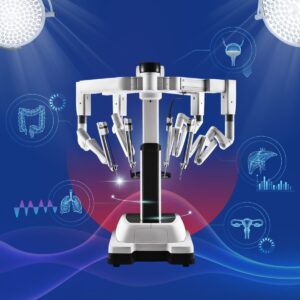Medical advancements in surgery have continued to expedite the pace of changes, allowing better treatment outcomes for patients who require abdominal surgery, ranging from gallstones to pancreatobiliary diseases, e.g. liver cancer, pancreatic cancer and gallbladder cancer. Cutting-edge robotic-assisted system, the “da Vinci Xi” is designed to accommodate and seamlessly integrate a range of current technologies in surgical areas, including intraoperative 3D imaging, advanced instruments and anatomical access, enabling the surgeons to perform minimally invasive procedures in hard-to-reach surgical sites through small incisions. Indeed, the use of the da Vinci Xi is associated with less pain and a shorter operative time.
Advances in abdominal surgery
Surgery remains a treatment of choice for a wide variety of abdominal diseases, particularly those that can potentially progress to severe and life-threatening conditions. Abdominal surgery covers a broad range of procedures. Certain abdominal issues can be successfully treated with minimally invasive techniques whereas open or conventional approach is a preferred option in some abdominal conditions. Minimally invasive surgery using laparoscope only requires small incisions with superior advantages of less pain, reduced postoperative complications and faster recovery, compared to one large incision with more pain and typically delayed recovery. Laparoscopic surgery uses the aid of a laparoscope — a thin rod attached with a camera at the end to visualize the inside of abdominal cavity on the monitor. Laparoscopic surgery requires small incisions, one is for the camera and the others are for the surgical instruments, enabling the surgeon to manipulate the surgical area without opening it all the way up. The da Vinci system is an advanced technology designed to enable surgeons to perform robotic-assisted, minimally invasive surgery, particularly in anatomically challenging areas and complex procedures.
What is the da Vinci Xi?
The da Vinci Xi is an advanced robotic surgical system using specialized technology that enhances the capabilities of surgeon’s hands. Using computer system, four surgical arms consisting tiny instruments with wrists at the tip allow surgeons to perform procedures in difficult-to-reach or complex areas with precise movements and better dexterity enhanced magnification. A special high-definition camera attached provides magnified 3D views of the operating area, leading to high degree of surgical accuracy and patient’s safety. For every movement, the surgeon makes at the console standing next to the surgical arms and the da Vinci robot replicates every move inside patient’s body on a smaller scale. The surgeon has complete control during the entire procedure.
What are abdominal conditions that can be treated with the da Vinci Xi?
The da Vinci Xi has been widely applied to the surgical treatment of abdominal diseases, such as:
- Gallstones: Gallstones are one of the most common digestive diseases in which small stones are formed in the gallbladder. The stones are mainly caused from the precipitation of either calcium salts or cholesterol in bile. Contributing factors often include obesity, hypercholesterolemia and excess estrogen. Alarming signs are flatulence, bloating or having chronic digestive problems after consuming high-fat diets, severe and sudden pain in the upper right abdomen that might radiate to the right shoulder, nausea and vomiting as well as fever with chills. If left untreated, it can lead to serious complication or death.
- Hernias: Hernias can be found in both men and women. Hernias occur when an organ especially small intestine protrudes through a weakened spot or tear in the abdominal wall. Hernias cause a bulge or lump in the affected area, depending on individuals such as groin (inguinal hernia), umbilicus (umbilical hernia) and diaphragm (hiatal hernia). Hernias are often asymptomatic. Nevertheless, the most common symptom is pain or discomfort usually at the lower abdomen. Without surgery conducted in a timely manner, it can lead to incarcerated and strangulated hernias in which emergency surgery is required.
- Liver cancer: Liver cancer is more predominant in men. It is often asymptomatic during its early stage. Once advanced with larger size, signs and symptoms are pain in the right upper abdomen, abdominal tightness, loss appetite, unintentional weight loss, flatulence or bloating and indigestion. In some cases, abdominal mass is palpable. Treatment hinges upon detected stage and its severity. Surgery is a preferred option in those whose liver masses are considerably small without the presence of cirrhosis and spreading (metastasis) to other organs. Depending on stages, liver surgery can be a liver resection – to remove certain part of the liver and liver transplant. The consideration will be made by the expert specialists.
- Pancreatic cancer: Most pancreatic cancers are diagnosed after age 45. Pancreatic cancer appears differently, depending on which part of the pancreas the tumor is formed, whether the head or the tail. Common signs of cancer of the head of the pancreas are jaundice caused by the obstruction of bile ducts, fatigue, weight loss, loss appetite and enlarged liver. Cancer of the tail of the pancreas does not usually manifest any noticeable symptoms until the size of the cancer gets bigger. Surgery to remove pancreatic cancer can help patients live longer, especially in its early stages before spreading to other organs. Due to the complex structure of the pancreas, pancreatic surgery must be performed by the surgeon specialized in the hepatopancreatobiliary system.
- Gallbladder cancer: Gallbladder cancer develops when malignant cells form in the tissues of the gallbladder. Signs and symptoms of gallbladder cancer are abdominal pain in the right side, bloating, nausea and vomiting, loss appetite, unintentional weight loss, jaundice, and itchy skin. If detected and diagnosed early, surgery to remove gallbladder is the best treatment option. Nevertheless, treatment planning and recommendation for each patient will be made by the specialists.
What are advantages of the da Vinci Xi for minimally invasive abdominal surgery?
The surgical procedure for various diseases mentioned above can be very complex which require many steps of precise dissection, suture, and reconnection of multiple organs together. Although, these can be done with current laparoscopic technique and instrument but it requires tremendous skill of the surgeon. Robotic-assisted platform will help enhance performance of surgeon in these procedures.
The fourth generation of the da Vinci system yields benefits, including:
- Better access: Robotic arms are capable of free movements of nearly 360° on seven axes, thereby improving access to anatomically challenging or hard-to-reach areas
- Built-in tremor-filtration: Built-in tremor-filtration eliminates the surgeon’s hand tremors and involuntary movements, allowing more surgical accuracy.
- More precise surgery: Surgery can be carried out efficiently since the robotic arm’s movements are highly precise with greater range of motion. The arms rotate instruments interchangeably in tight spaces in ways that are not otherwise possible.
- Improved visualization: A sophisticated camera provides magnified, high-definition views of the surgical area with a better visualization of vessels, nerves and muscles nearby, resulting in less complications caused by damages to the surrounding areas.
- Multiquadrant surgery: It allows a single operation on several connected organs located in different abdominal quadrants without moving the position of the patient.
- Faster recovery: Due to small incisions, patients often experience less pain, shorter hospital with a quick return to daily life.
Nowadays, we live in a world with fast changing pace, especially in medical technologies. All these developments have sole propose not only to cure patient’s diseases but also to decrease complication and enhance recovery, so that patient can go back to live a normal life. Bangkok hospital surgery center has determination to continue our development and bring about the latest, safe and value-base medical technologies for taking care of our patient in response for all your trust in our care.



